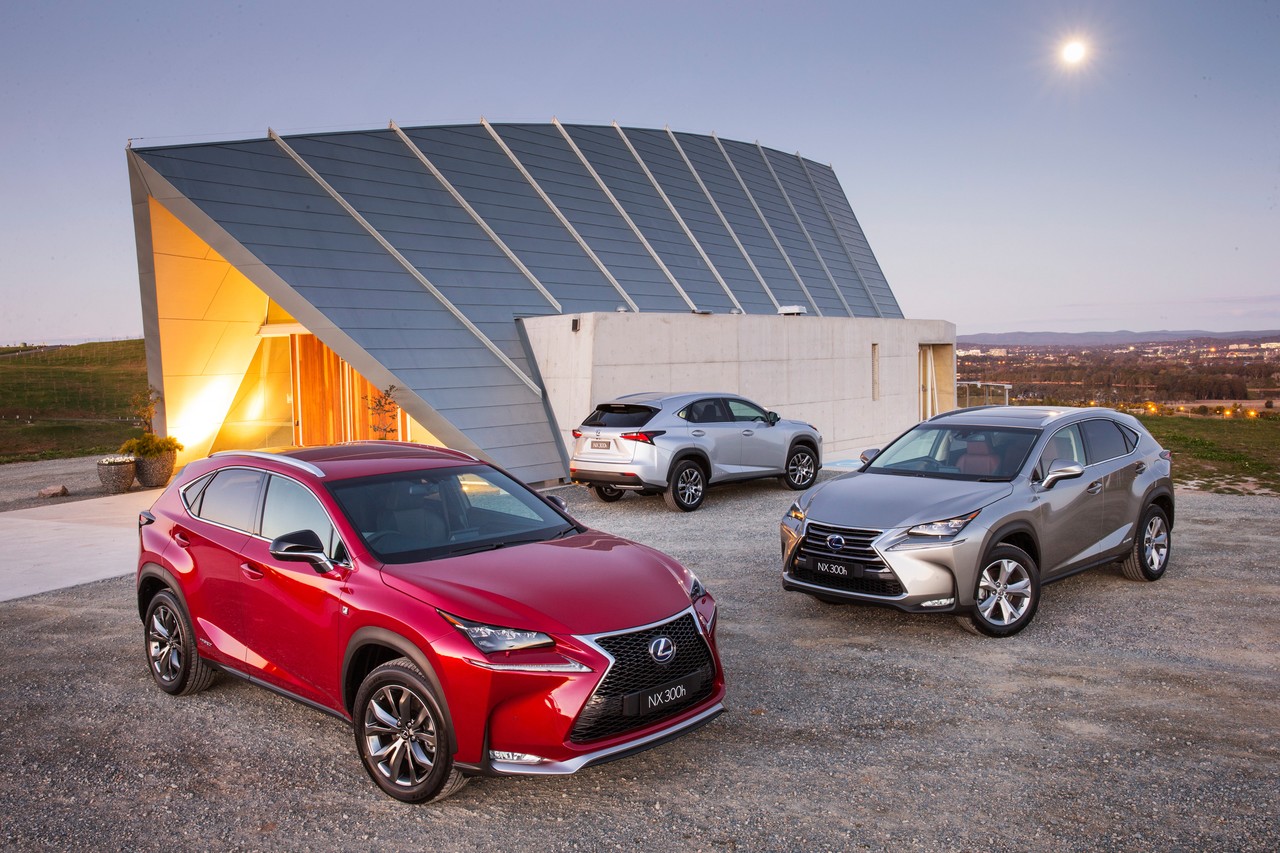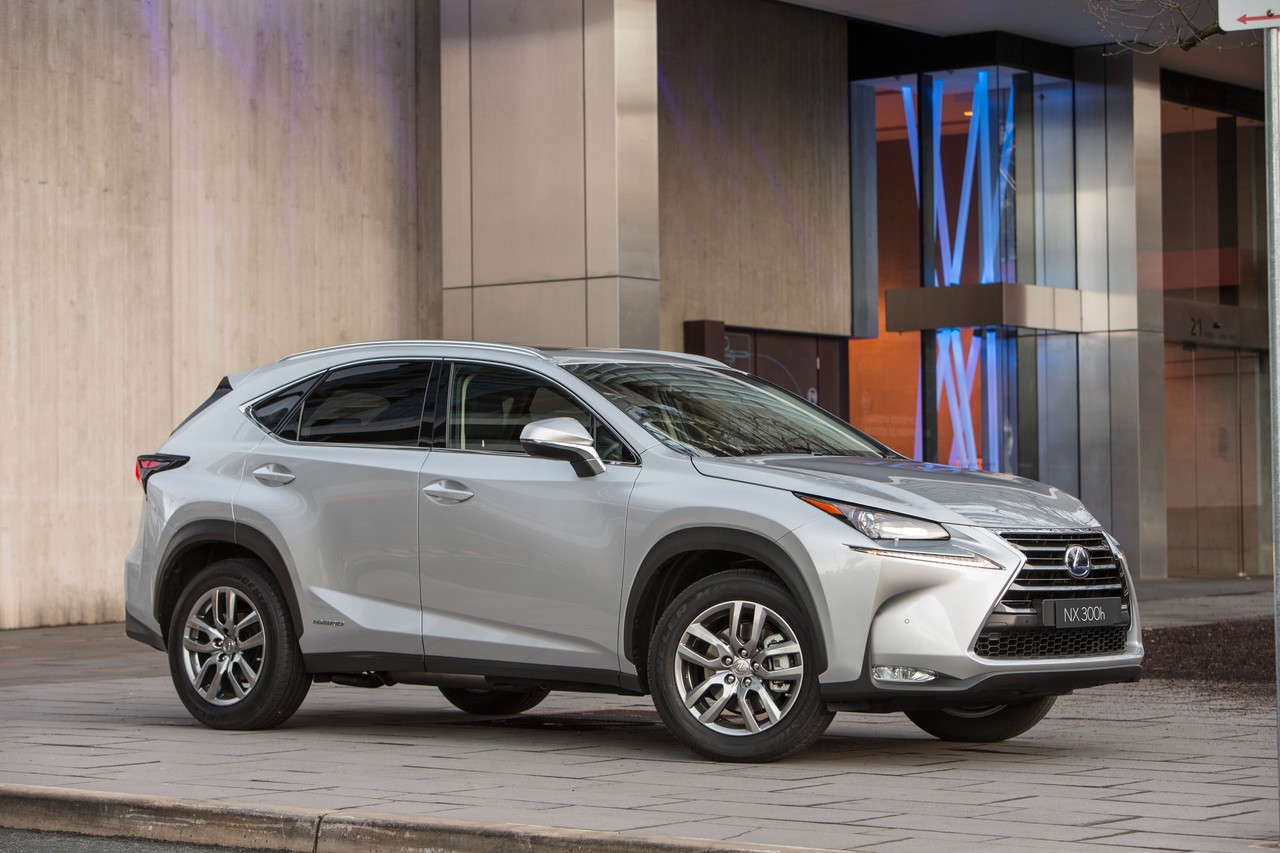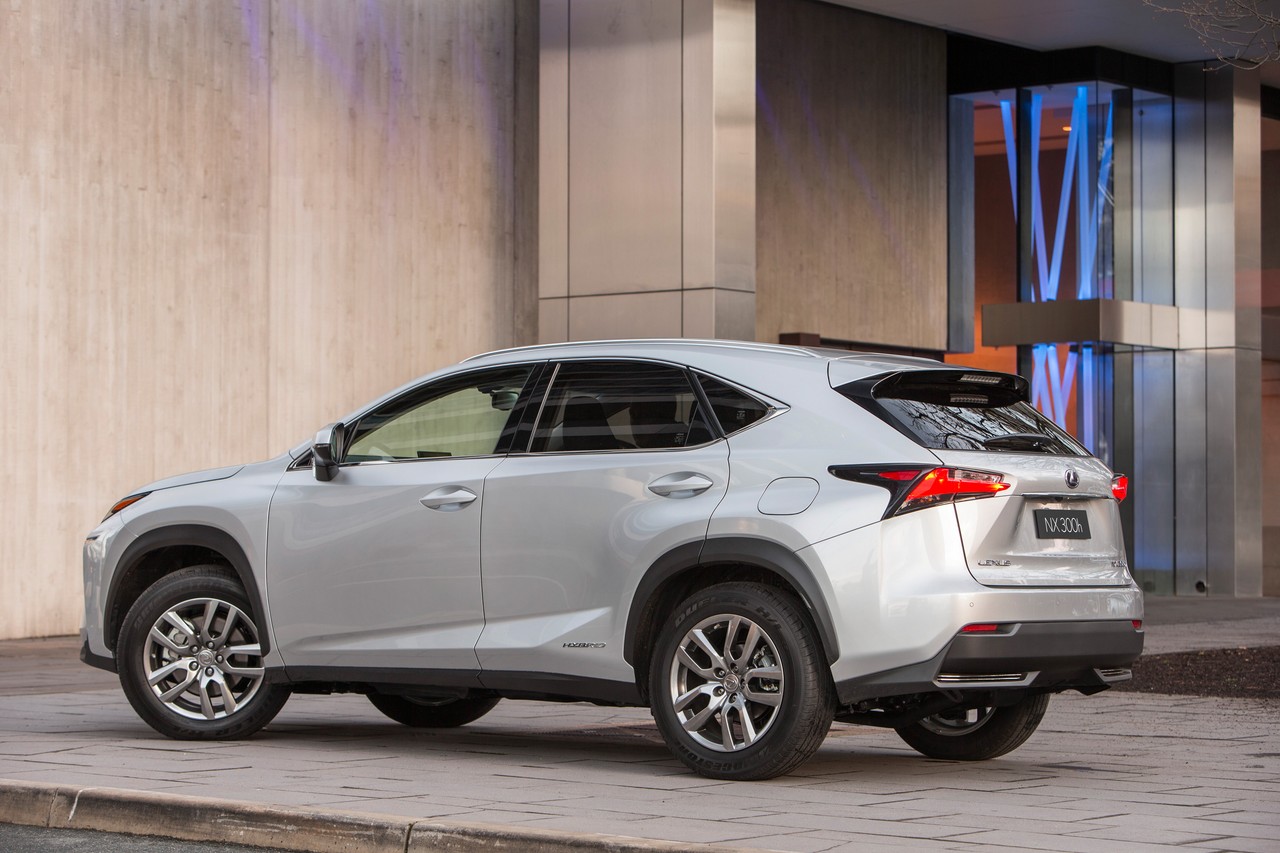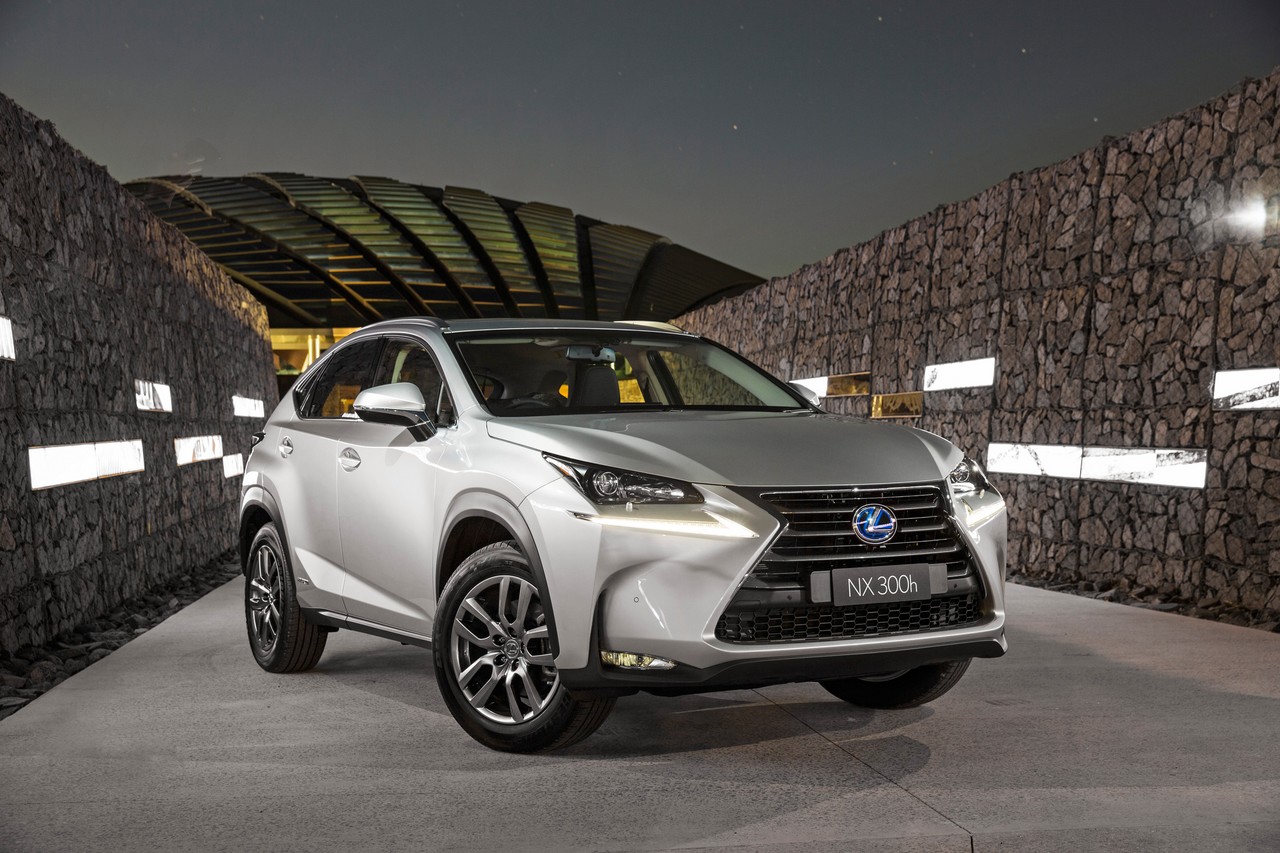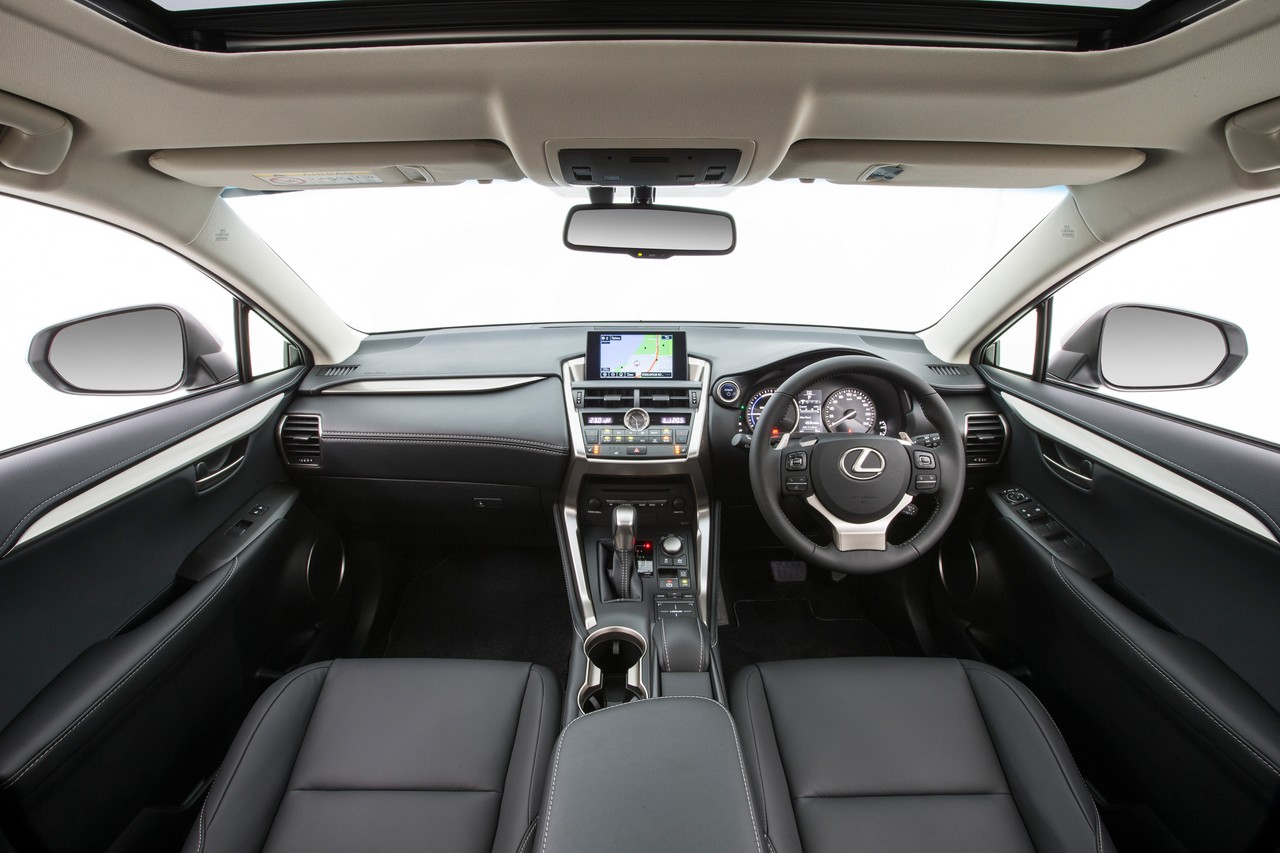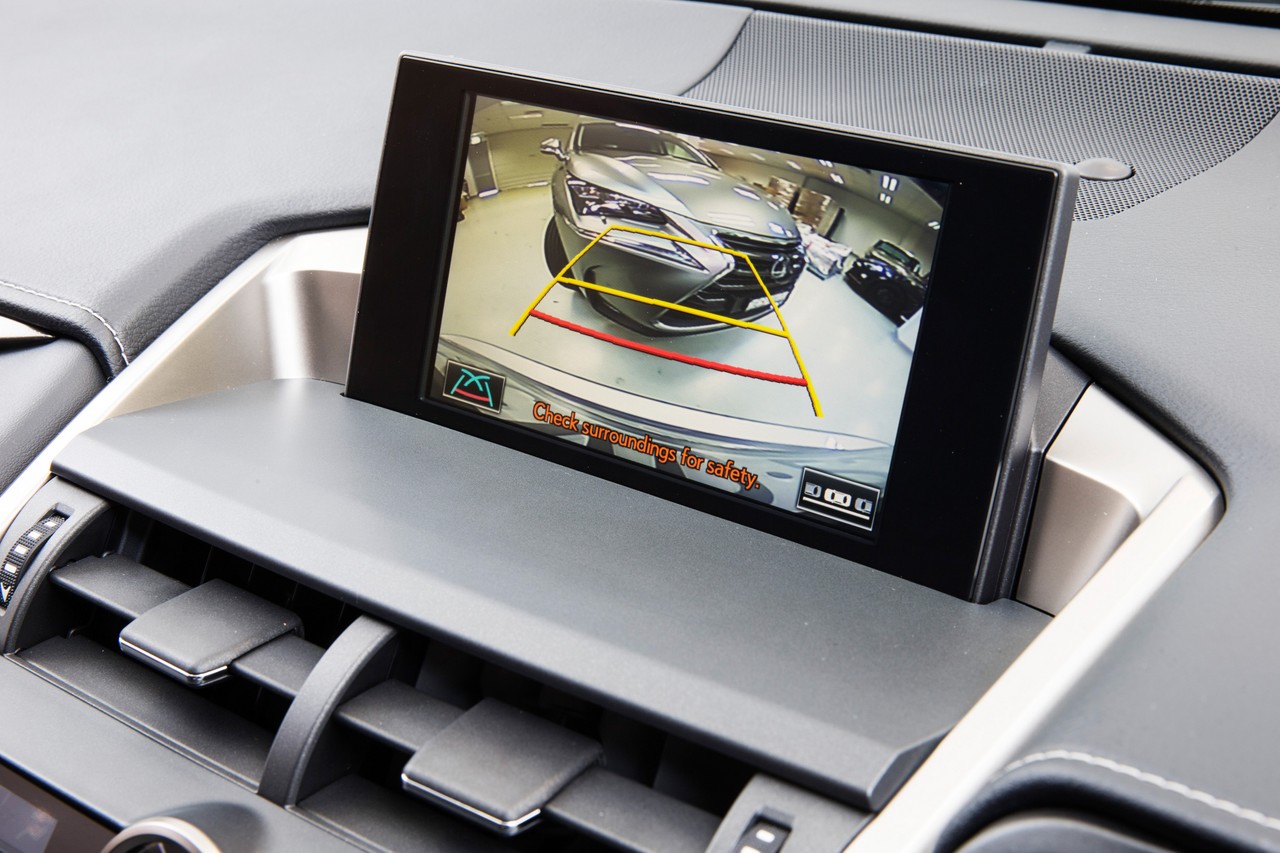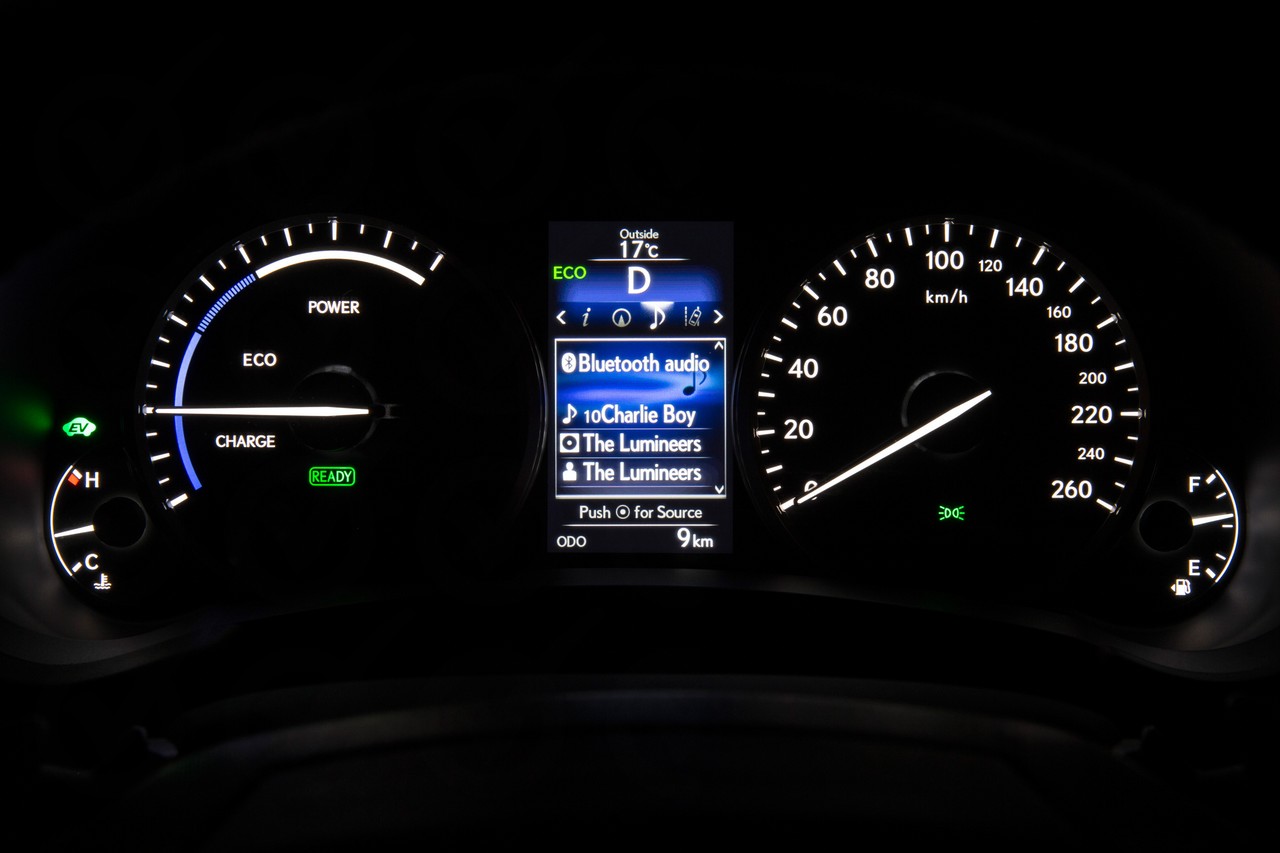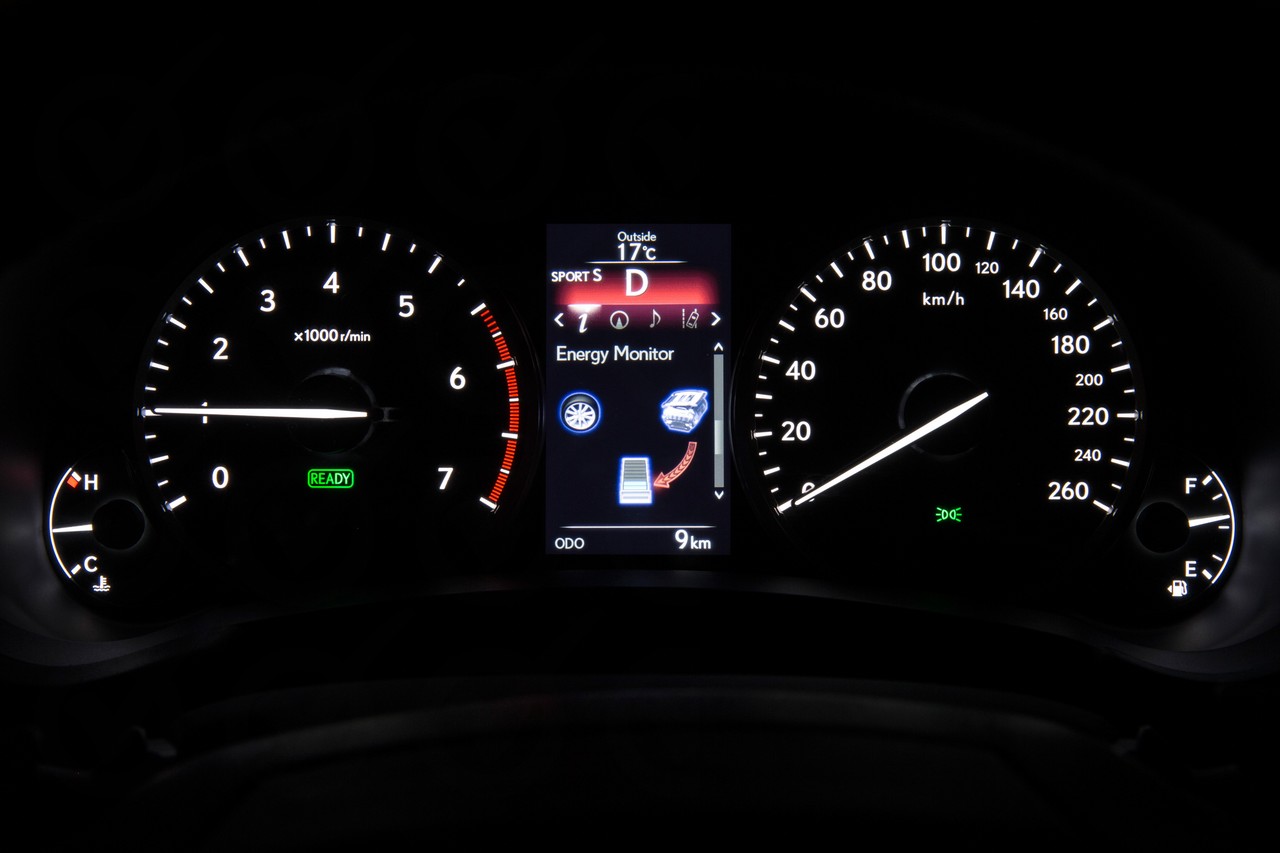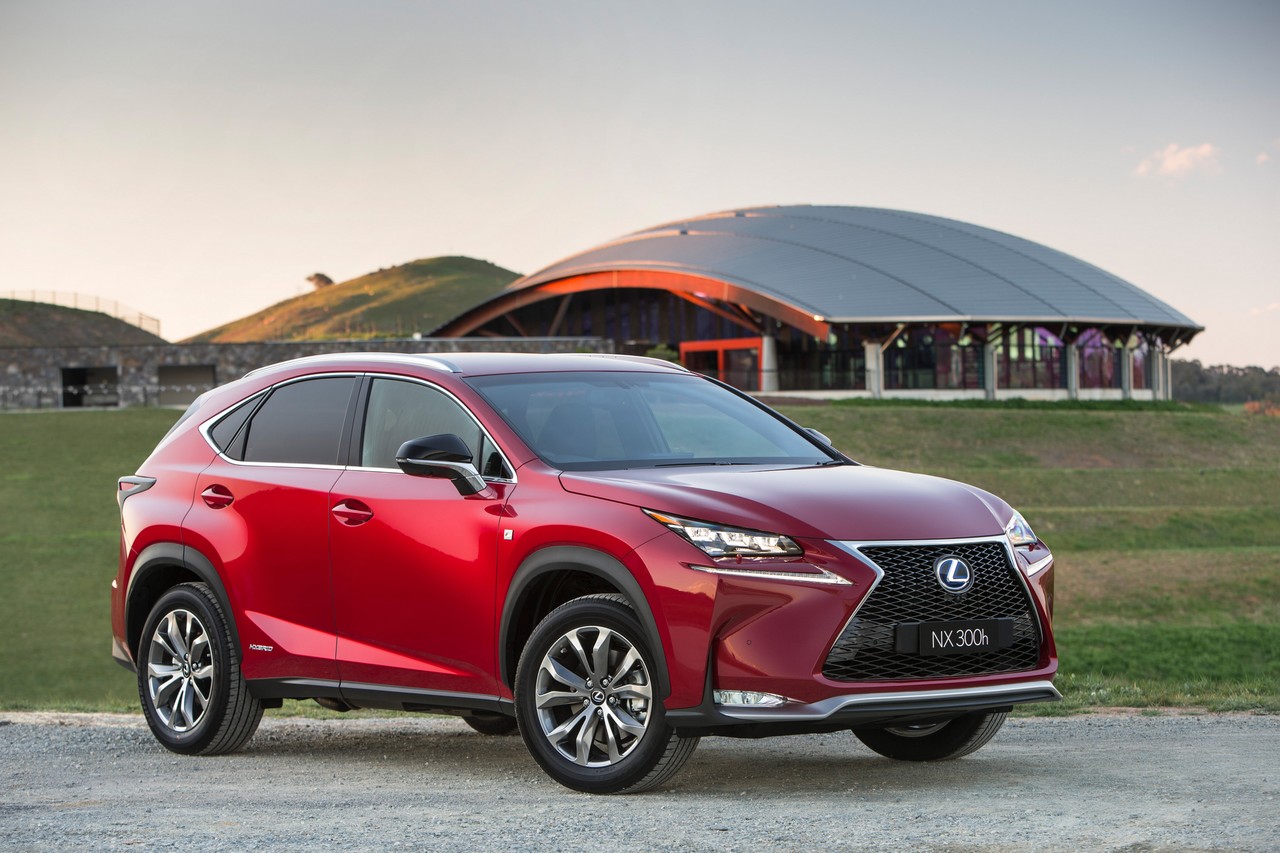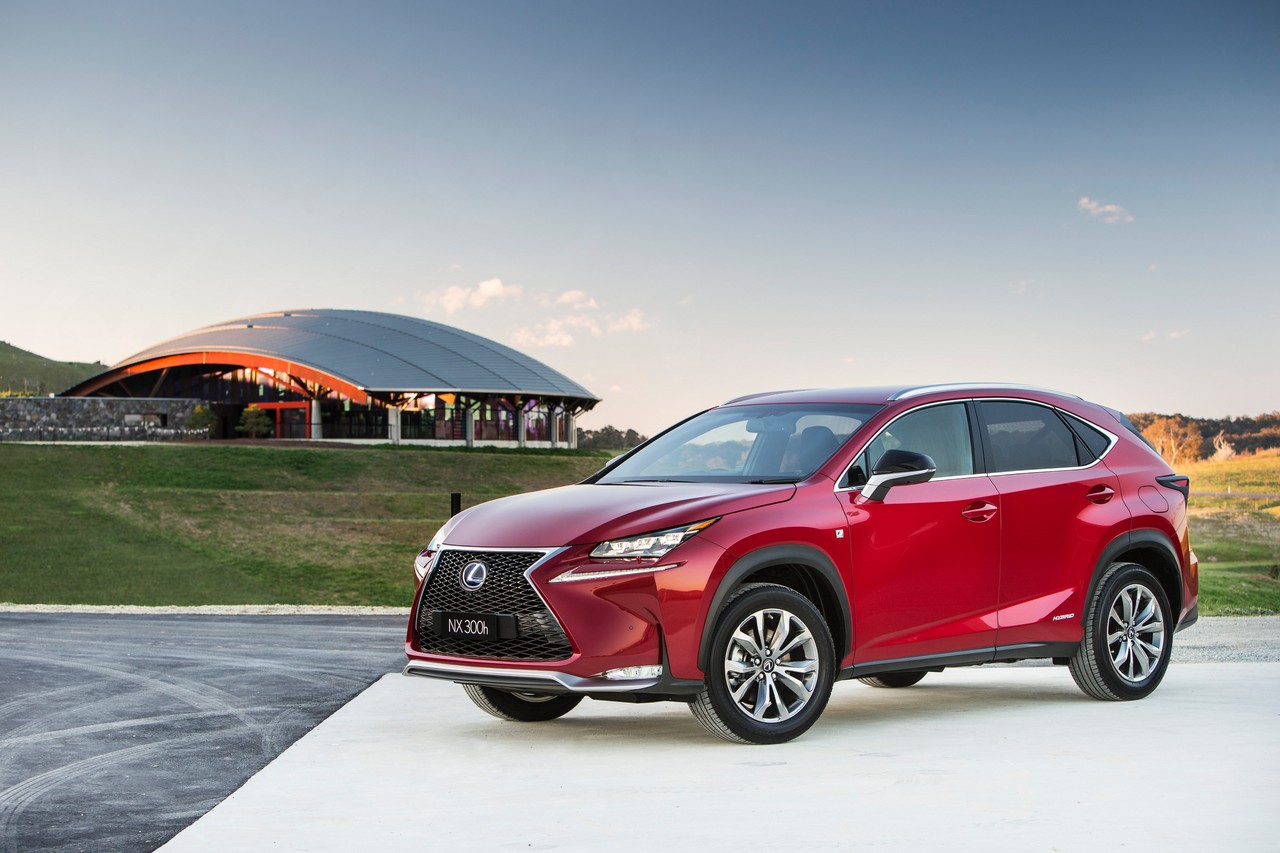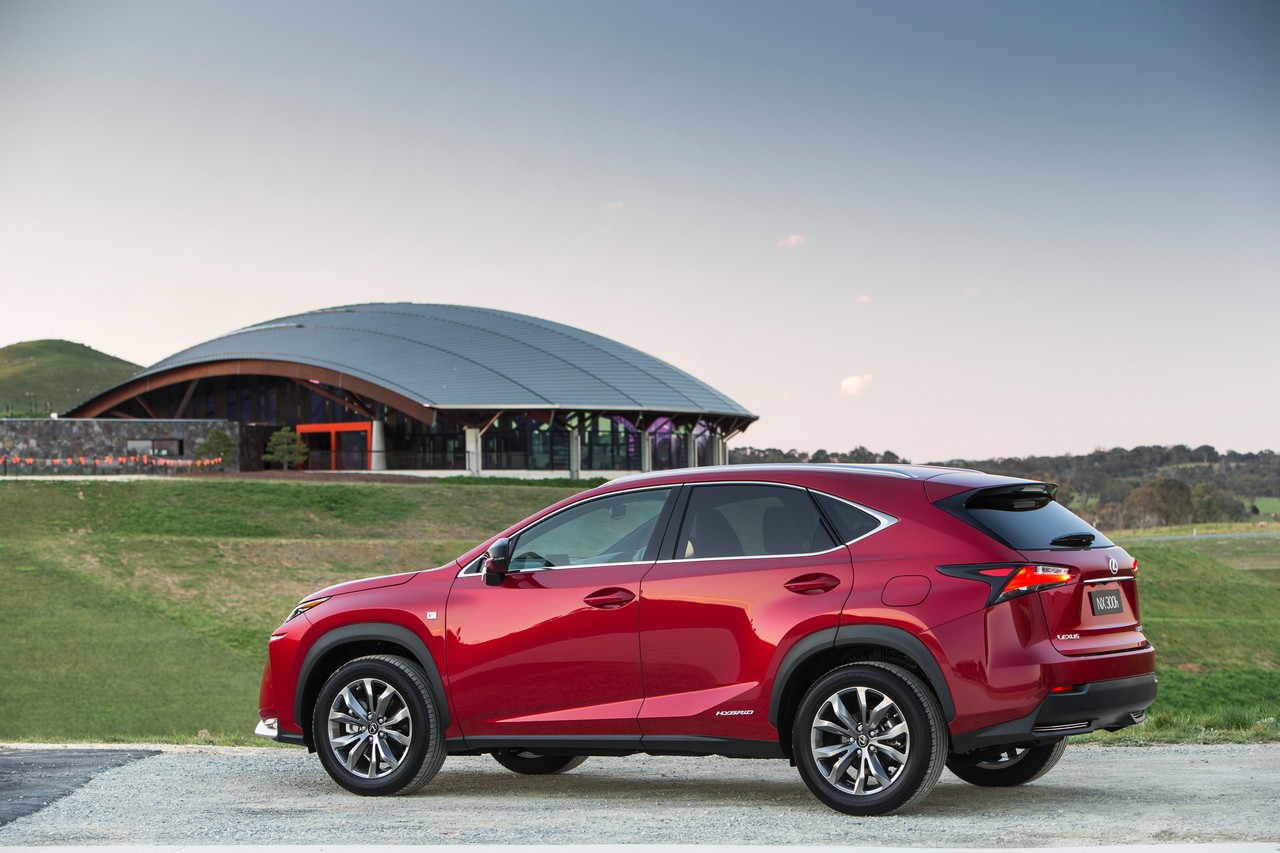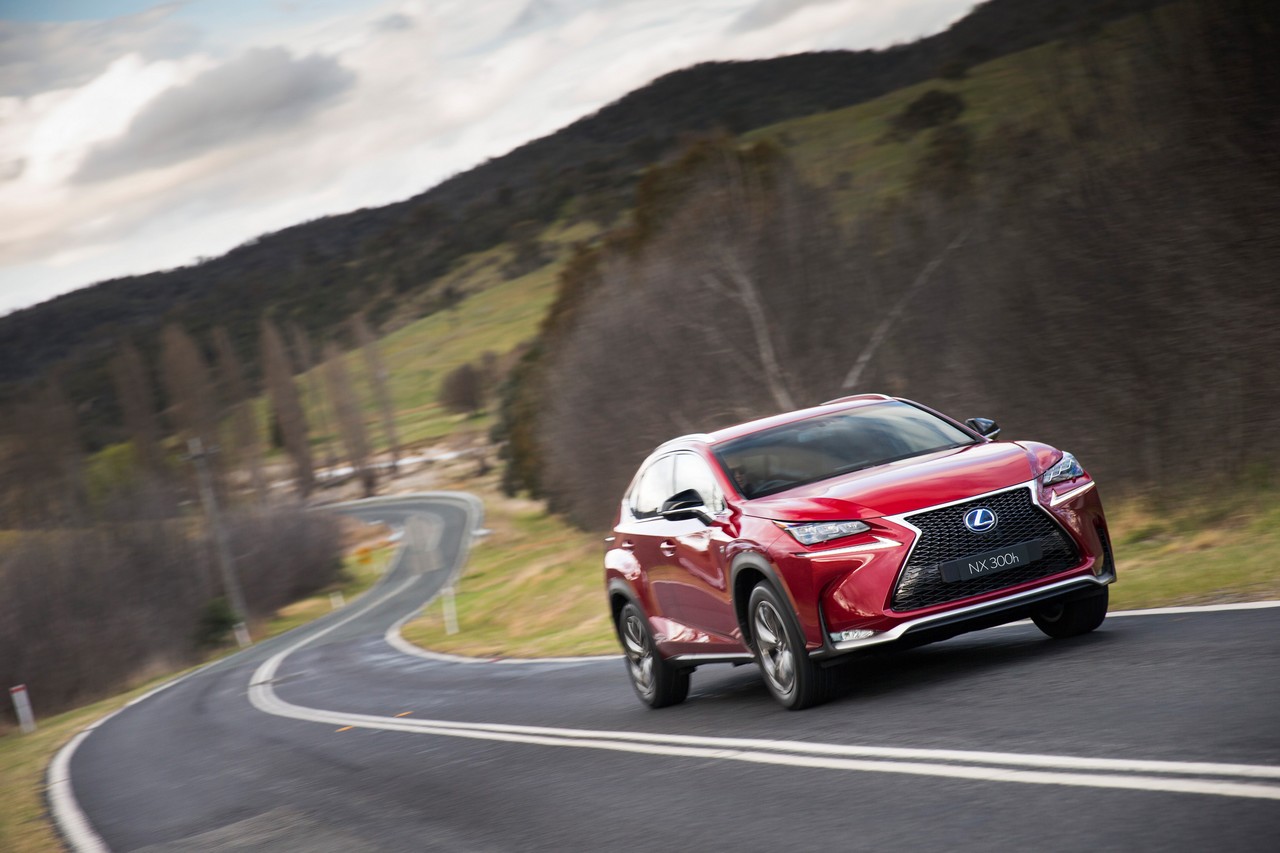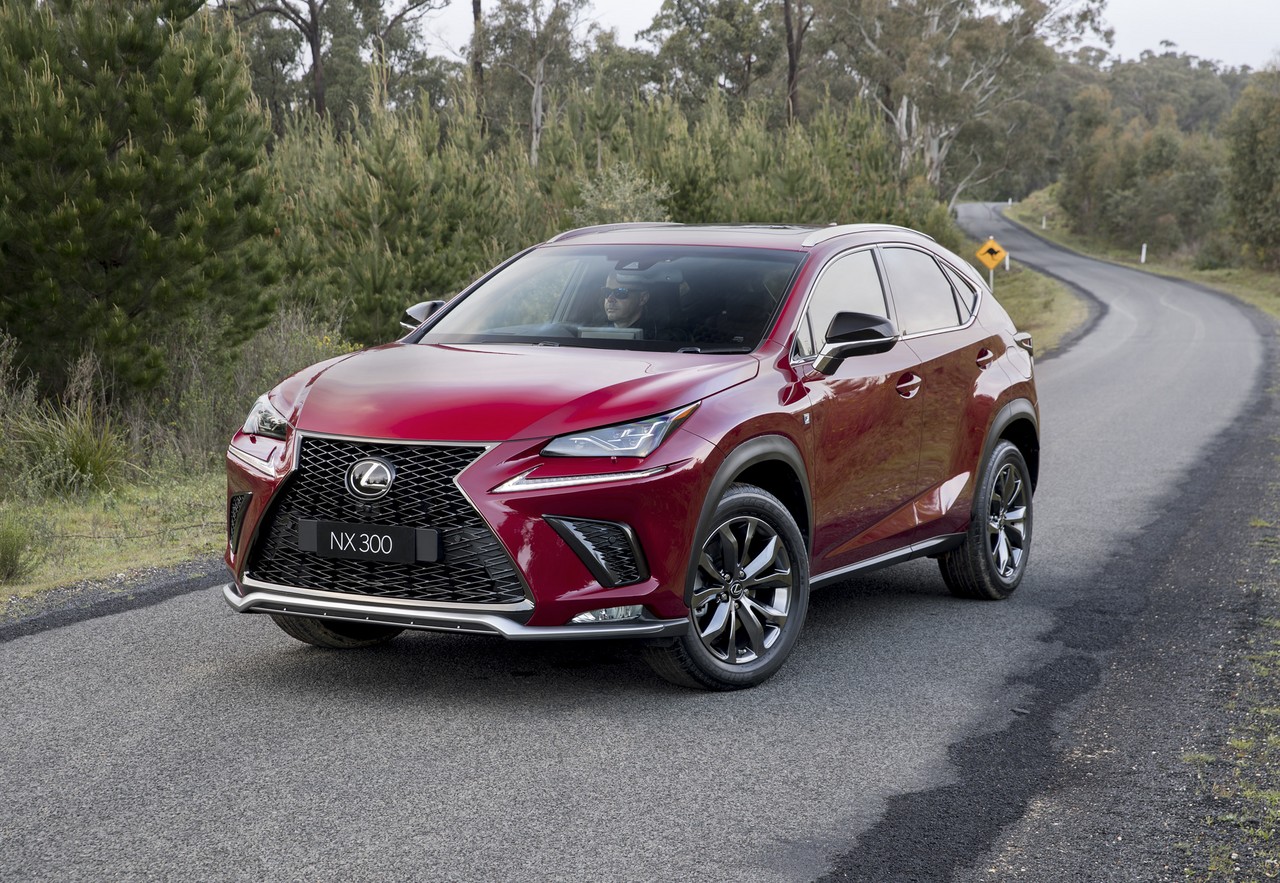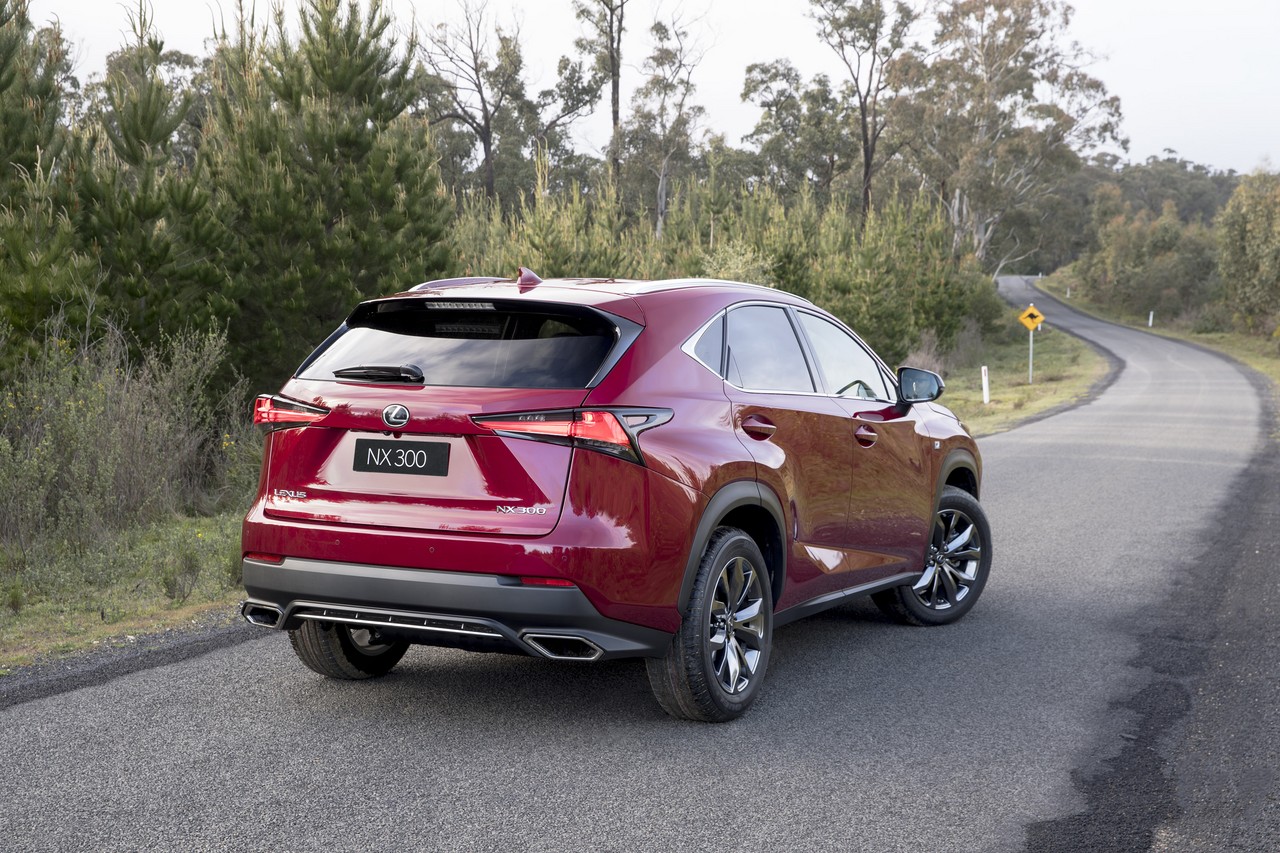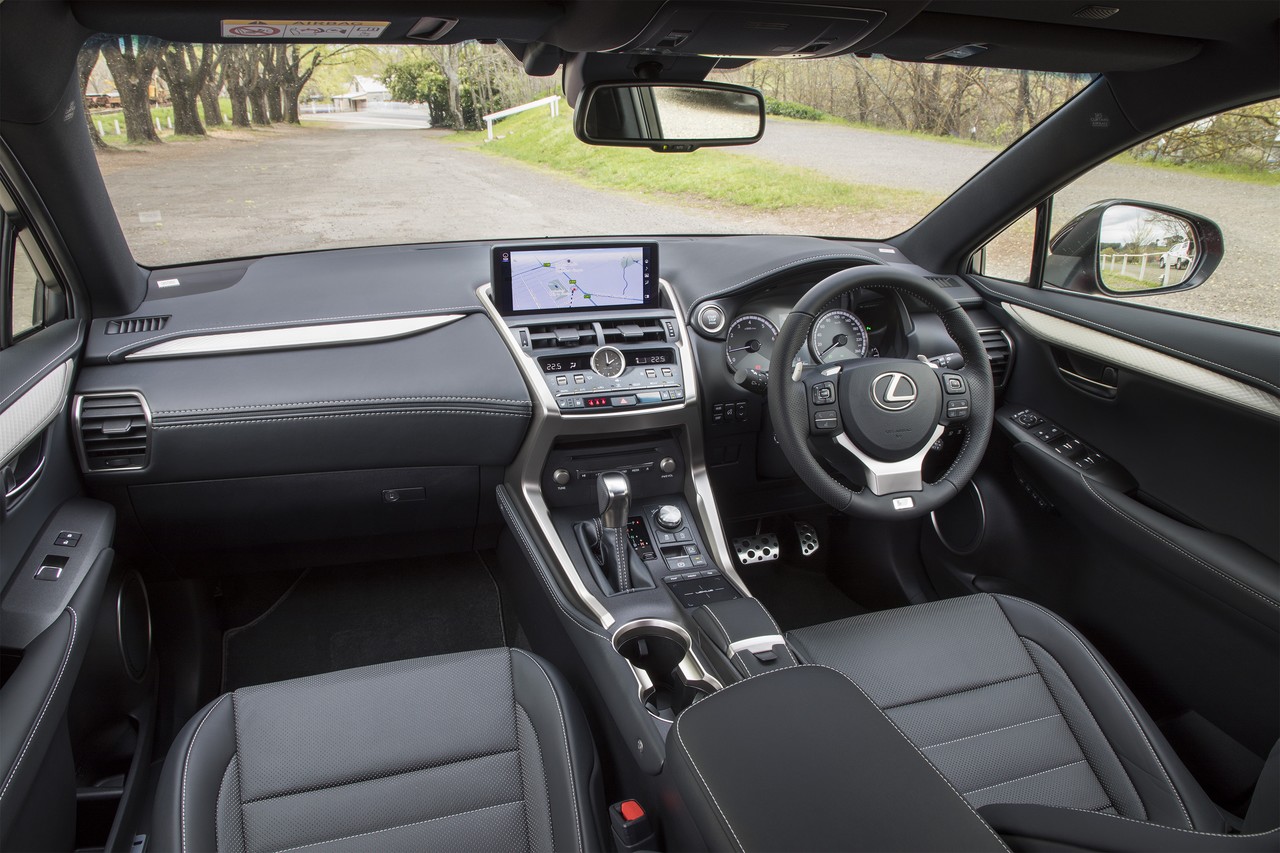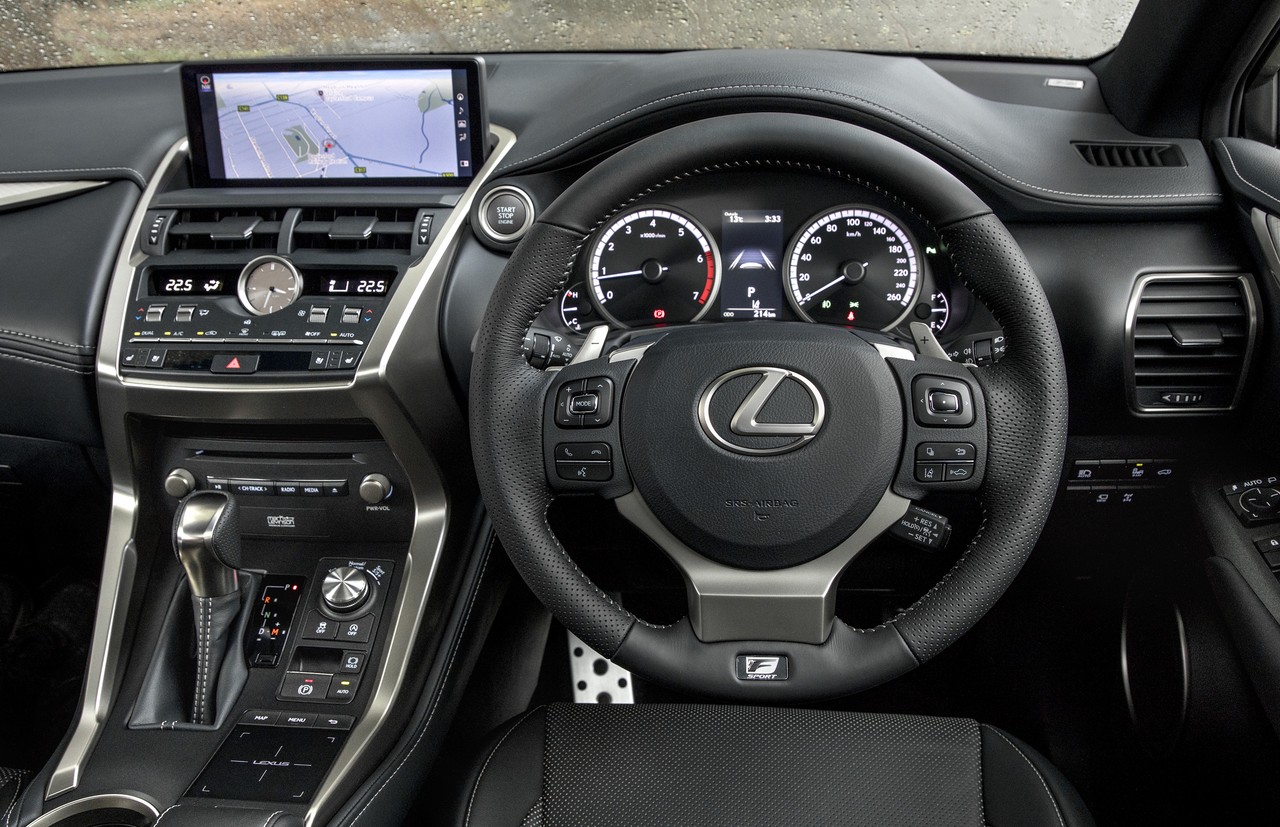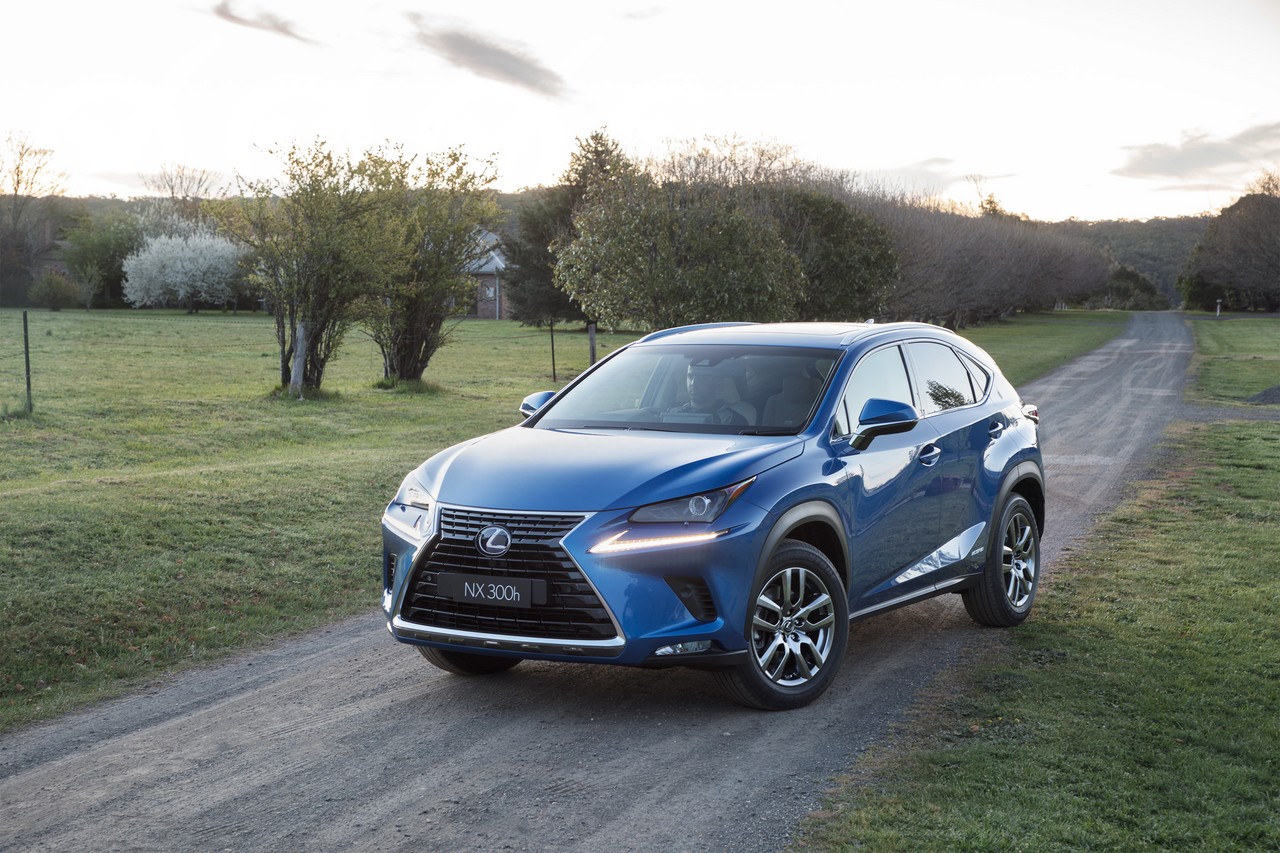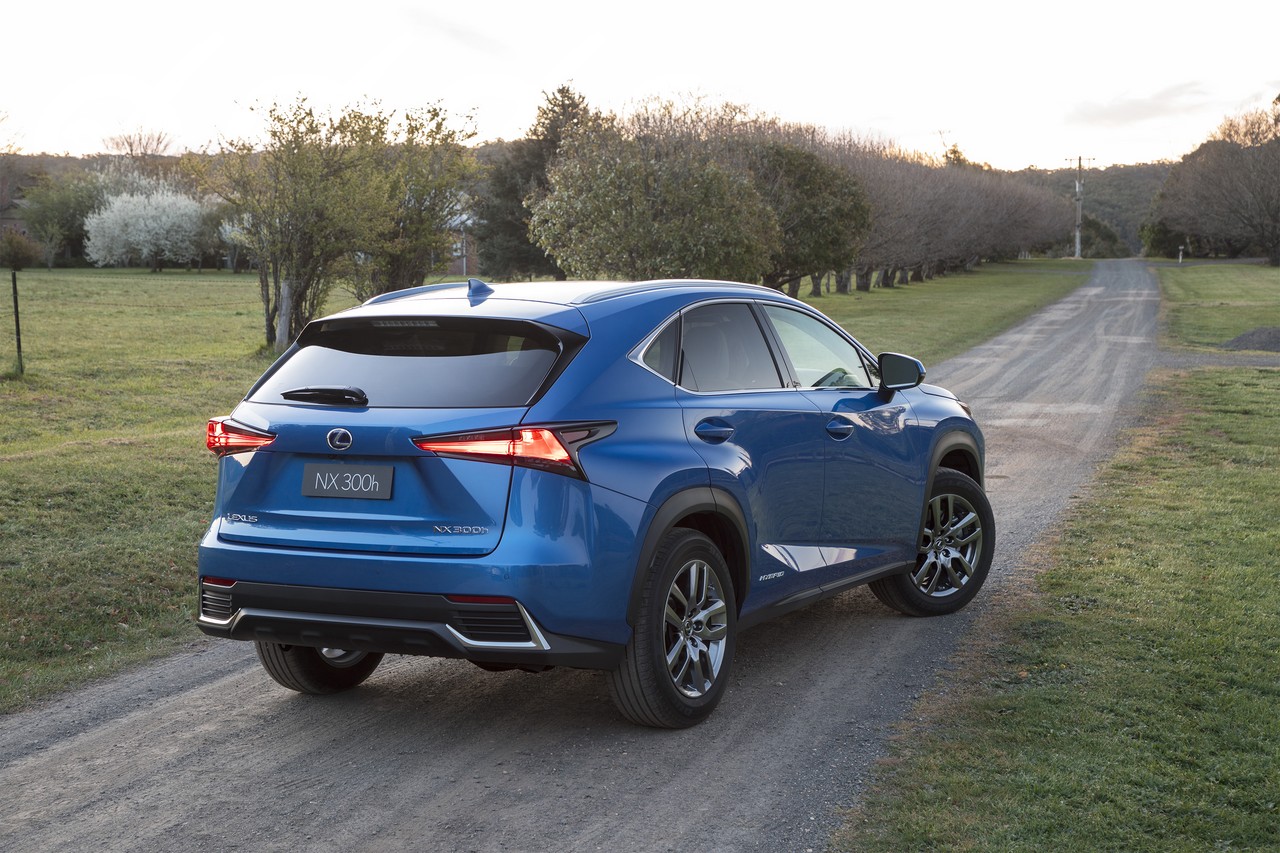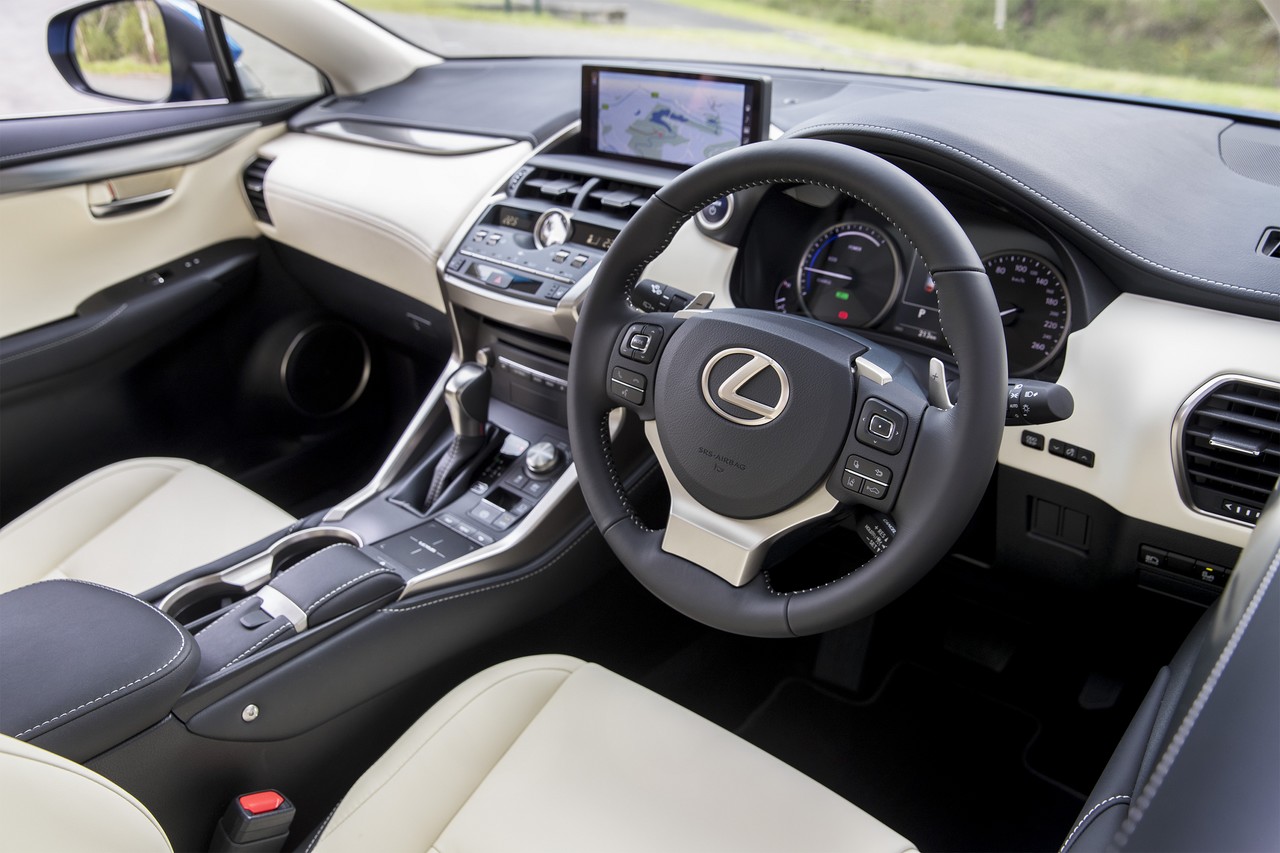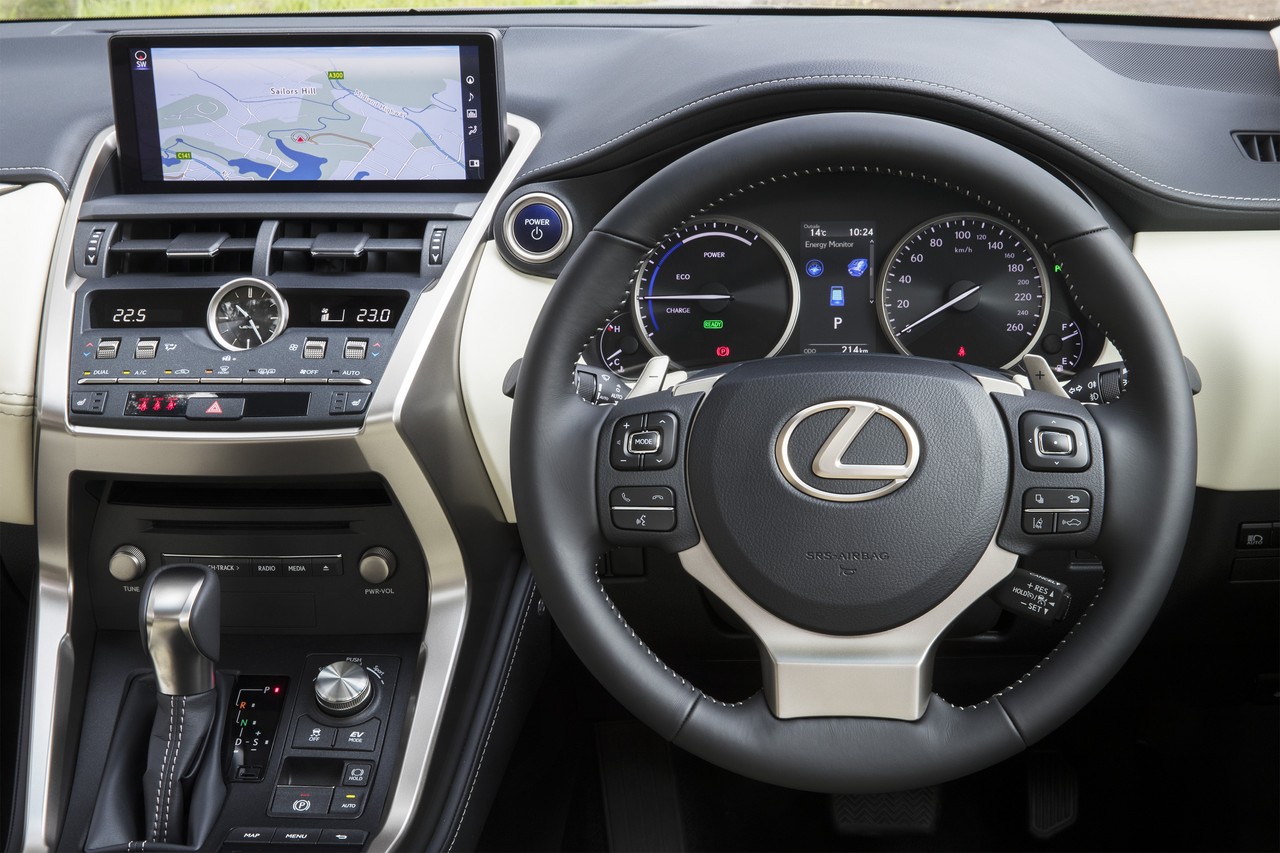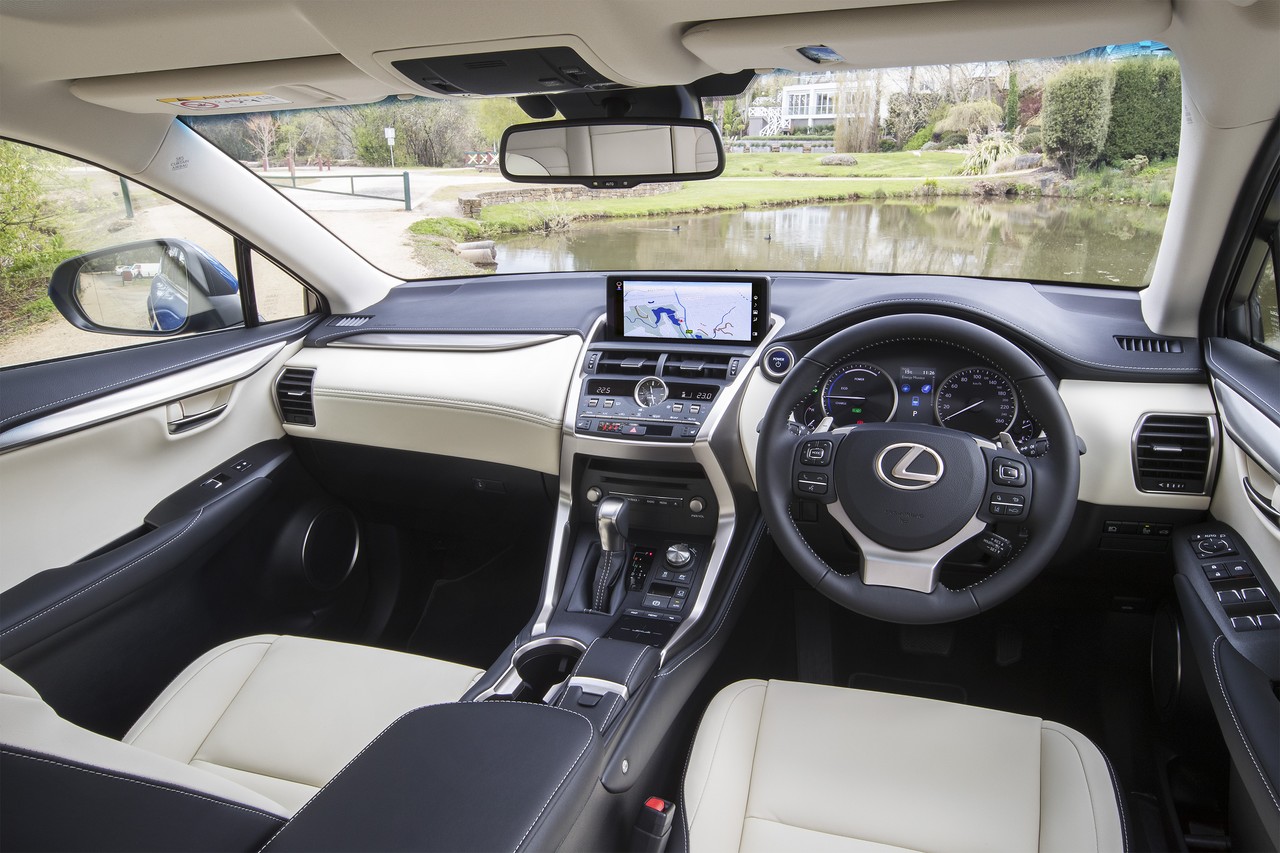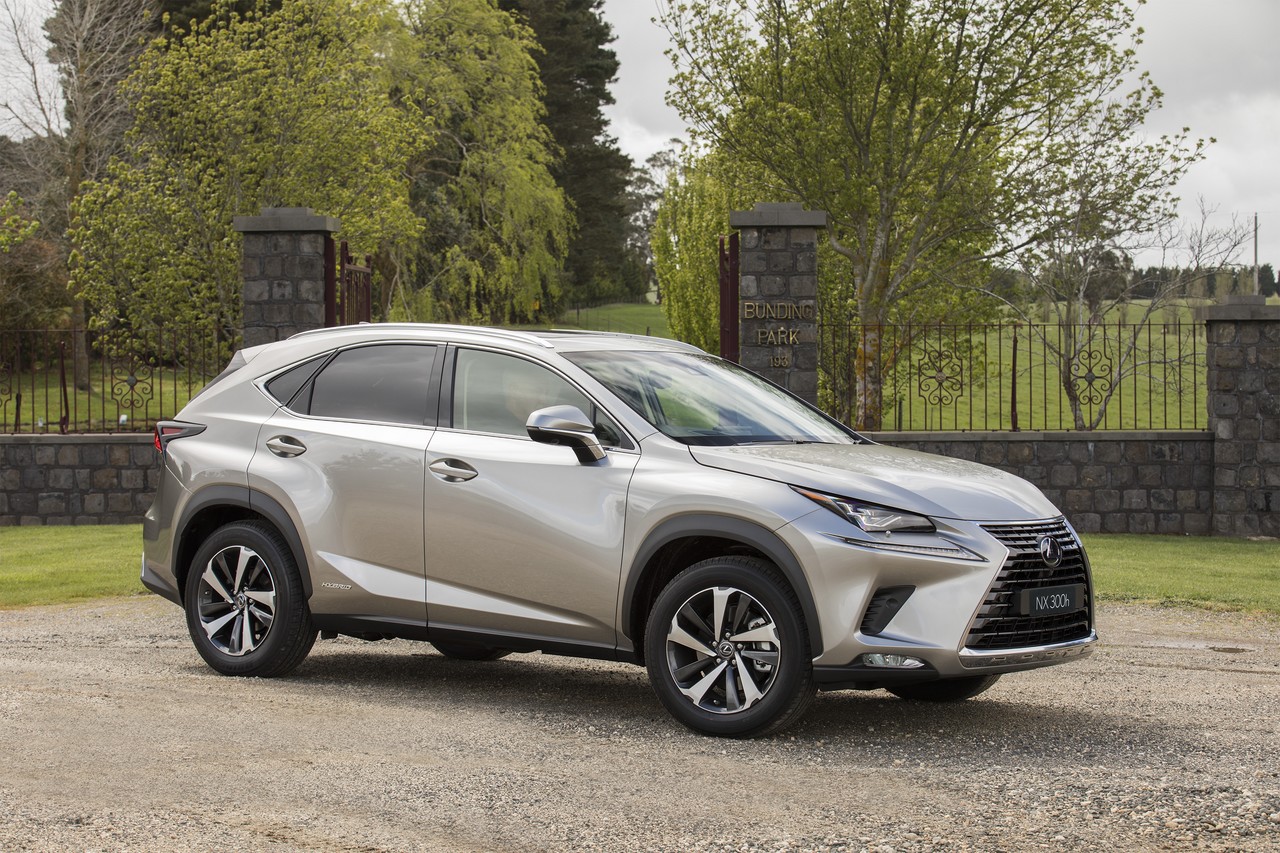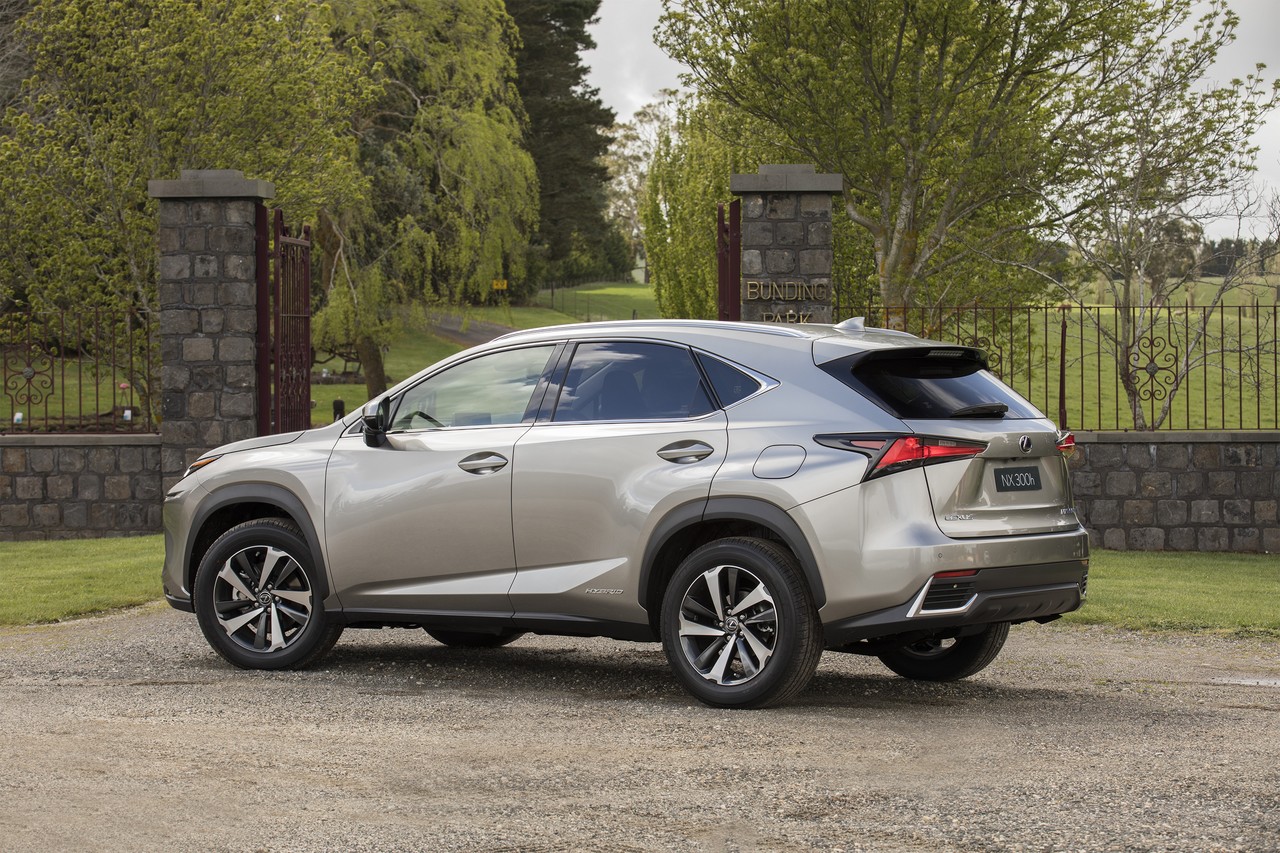
- For NX 200t, sophisticated 2.0-litre 8AR-FTS turbo engine is responsive and economical
- For NX 300h, refined and efficient hybrid powertrain
- High quality interior fit and finish
- Accurate, well-weighted steering
- Suspension lacks low-speed compliance
- Raked roofline compromises cargo space and rear visibility
- Less interior space than rivals such as the Audi 8R Q5 and BMW F25 X3
Review: Lexus AZ10.I NX (2014-17)
Overview
Released in Australia in October 2014, the Lexus AZ10 NX was a mid-size SUV. Manufactured in Japan, the NX range initially consisted of the NX 300h, with the NX 200t following in January 2015. As per the table below, both the NX 200t and NX 300h were available in Luxury, F Sport and Sports Luxury variants.
NX 300h: 2AR-FXE engine
The NX 300h had a ‘Hybrid Synergy Drive’ powertrain which consisted of:
- a 2.5-litre 2AR-FXE four-cylinder Atkinson cycle petrol engine which had an alloy block and cylinder head, double overhead camshafts, four valves per cylinder, variable intake valve timing (‘VVT-i’) and a compression ratio of 12.5:1;
- two 650-volt AC motor/generators;
- a step-up converter and inverter to draw current from the nickel metal hydride battery; and,
- an electronically-controlled continuously variable transmission (E-CVT).
Of the two motors/generators, one acted primarily as a generator while the other operated primarily as an electric drive motor (but could also function as a generator during regenerative braking). Furthermore, the compound planetary gear set consisted of two sets of planetary gears: the first planetary gear set acted as a power-split device (dividing petrol engine between the generator and the front axle), while the second worked as a reduction gear for the electric drive motor.
NX 200t: 8AR-FTS engine
The NX 200t was powered by Toyota’s 2.0-litre 8AR-FTS turbocharged petrol engine which had an aluminium block and aluminium cylinder head, direct and port injection (Toyota’s ‘D-4S’), a twin-scroll turbocharger (which provided maximum boost pressure of 17 psi or 1.17 bar), an integrated exhaust manifold, double overhead camshafts and four valves per cylinder.
While the exhaust valves had standard variable valve timing (Variable Valve Timing with Intelligence, or ‘VVT-i’), the intake valves had a mid-position camshaft lock mechanism which retarded the continuously variable valve timing, known as Variable Valve Timing-intelligent Wide (VVT-iW). The ability to retard intake valve timing enabled the engine to use
- an Atkinson cycle for low-rev operations to minimise fuel consumption; and,
- an Otto cycle at higher engine speeds for greater power.
The 8AR-FTS engine also featured a ‘stop-start’ system which enabled it to shut down when the vehicle was stationary in traffic to reduce fuel consumption.
| Variant | Drive | Motor | Trans. | Peak power | Peak torque | |
|---|---|---|---|---|---|---|
| NX 200t | Luxury | FWD | 2.0-litre turbo petrol I4 (8AR-FTS) | 6sp auto | 175 kW at 4800-5600 rpm | 350 Nm at 1650-4000 rpm |
| Luxury, F Sport, Sports Luxury |
AWD | |||||
| NX 300h | Luxury | FWD | 2.5-litre petrol I4 (2AR-FXE) | CVT | 114 kW at 5700 rpm | 210 Nm at 4200-4400 rpm |
| Electric motors | 105 kW | 270 Nm | ||||
| Combined | 147 kW | N/A | ||||
| Luxury, F Sport, Sports Luxury |
AWD | 2.5-litrepetrol I4 (2AR-FXE) | CVT | 114 kW at 5700 rpm | 210 Nm at 4200-4400 rpm | |
| Electric motors | 105 kW | 270 Nm | ||||
| Combined | 147 kW | N/A | ||||
NX 300h: E-Four all-wheel drive system
The NX 300h was available with Lexus’ ‘E-Four’ all-wheel drive system. In this system, the rear wheels were driven exclusively by an electric motor while an on-board computer calculated the optimum front:rear torque distribution (up to a maximum split of 72:28) and effected this torque distribution via the hybrid drive system.
NX 200t: all-wheel drive system
The NX 200t all-wheel drive system utilised an electronically-controlled coupling and enabled the driver to select from Auto, Lock and Sport modes:
- In Auto Mode, the engine’s torque was directed to the front wheels (to minimise fuel consumption), with all-wheel drive only engaged for additional traction when needed;
- In Sport Mode, 10 per cent of the engine’s torque was directed to the rear wheels, increasing to 50 per cent under certain conditions. When cornering, for example, additional power was sent to the rear wheels – based on steering angle and yaw rate – to improve traction. Furthermore, torque could be directed to the rear wheels when understeer was anticipated, before wheel slip occurred; and,
- At speeds below 40 km/h, Lock Mode provided a fixed 50:50 front:rear torque split for maximum traction. Beyond 40 km/h, however, Lock Mode would automatically revert to Auto Mode.
Dimensions
The Lexus AZ10 NX was 4630 mm long, 1845 mm wide, 1645 mm tall (including the shark’s fin antenna) and have a 2660 mm long wheelbase. Furthermore, the NX had a drag coefficient of 0.33 Cd.
Suspension
The Lexus AZ NX had double wishbone front suspension with coil springs and gas-pressurised dampers, and double wishbone rear suspension with trailing arms, separate coil springs and dampers. Beyond this, however, the NX 300h had sprung-weight damping control to reduce pitch when driving on uneven surfaces and improve ride comfort.
The Lexus NX F Sport and Sports Luxury were both fitted with performance dampers and Lexus’ Adaptive Variable Suspension (AVS) which provided variable, electronically-controlled damping and selectable drive modes (Eco, Normal, Sport S and Sport S+).
Safety equipment
Standard safety equipment for the Lexus AZ10 NX included dual front airbags, dual front knee airbags, front side airbags, full-length curtain airbags, ABS, electronic brake force distribution, brake assist, electronic stability control, traction control and front seatbelts with pretensioners and load limiters.
The NX F Sport and Sports Luxury were both further equipped with –
- A Blind Spot Monitor (BSM): once the vehicle exceeded 40 km/h, sensors in the rear bumper could detect vehicles in the adjacent lanes. If the driver indicated to change lanes and a vehicle was detected, a warning tone would sound; and,
- Rear cross-traffic alert: when reversing, sensors in the rear bumper could detect approaching traffic which may cross the vehicle’s path. If crossing traffic was detected, a warning tone would sound.
Beyond this, the NX Sports Luxury was also fitted with following –
- Pre-Collision Safety (PCS) system: included pre-collision warnings (audible and visual), brake assist preparation, autonomous braking in emergency situations, retraction of the front seatbelts and airbag deployment preparation; and,
- Lane Departure Warning: used a camera sensor mounted near the rear view mirror to detect if the vehicle deviated from its lane position. If so, a warning tone would sound.
Euro NCAP testing
In Euro NCAP testing , the 2014 Lexus NX 300h received a five star safety rating which included an 82 per cent adult occupant protection rating and an 82 per cent child occupant protection rating. In the offset crash test, protection of the driver’s chest, thighs and lower legs were rated as good, though chest and foot protection was rated as adequate (i.e. a slight risk of serious injury). In the side impact test, driver protection was rated as good for all areas. In the more severe pole test, however, protection of the driver’s chest was marginal and abdomen protection was adequate.
Under ANCAP’s methodology , this testing resulted in a five star adult occupant protection rating with a score of 35.39 out of 37.
Brakes
The NX 200t and NX 300h had 328 mm by 28 mm vented front brake discs and 281 mm by 12 mm solid rear discs.
Features: NX Luxury, F Sport and Sports Luxury
For the Lexus NX 200t and NX 300h Luxury, standard features included 18-inch alloy wheels with Bridgestone Dueler 225/60 R18 100H tyres, a ten speaker Pioneer sound system with a digital amplifier, digital radio (DAB+), dual USB inputs, a 3.5 mm auxiliary input, Bluetooth mobile phone connectivity and audio streaming, satellite navigation, Lexus’ Enform connectivity system and Remote Touch controller, eight-way power adjustable and heated front seats, cruise control, front and rear parking sensors, a rear view camera, LED low beam headlamps and fog lamps, automatic headlights, rain-sensing wipers, 60:40 split and folding rear seats, remote central locking, a proximity key (Lexus’ ‘Smart Entry’), power adjustable and folding door mirrors, power windows, a power adjustable steering column, power-operated tailgate, push-button start (Lexus’ ‘Smart start’), an electrochromatic rear view mirror, tyre pressure monitoring, 12 volt power outlets, a trip computer and an immobiliser.
Relative to Luxury, the NX 300h F Sport and Sports Luxury were both further equipped with ten-way power adjustable and ventilated (i.e. heating and cooling) front seats, LED headlights, a 360-degree panoramic view monitor, driver’s seat memory settings, electrochromatic door mirrors, and a wireless induction charger for phone and mobile devices. Beyond this, however,
- The F Sport had Bridgestone Dueler 235/55 R18 100V tyres and featured steering wheel gearshift paddles, active sound control and ‘F Sport’ pedals, steering wheel, scuff plates and gear lever. The F Sport could also be identified by its unique spindle grille, bumpers and alloy wheels; while,
- The Sports Luxury had a Mark Levinson audio system with fourteen speakers and a twelve channel amplifier, all-speed active cruise control, a full-colour head-up display, a smart key card, moonroof and woodgrain trim.
Enhancement Packs
The NX 300h will be available with two ‘Enhancement Packs’ –
- Enhancement Pack 1: adds a Mark Levinson Audio system with fourteen speakers and a moon roof; and,
- Enhancement Pack 2: adds Pre-Collision Safety system (PCS), all-speed active cruise control, Lane Departure Warning, widescreen colour heads-up display (HUD), auto high beam, smart card key, the Mark Levinson audio system and a moon roof.
Brochure
Related links
- Press Kit: 2014 Lexus NX 300h (October 2014)
- Press Release: Lexus Introduces NX 200t SUV (January 2015)
Review: Lexus AZ10.II NX (2017-21)
Overview
Released in Australia in October 2017, the Lexus AZ10 Series II (AZ10.II) NX introduced styling and interior updates, as well as the fitment of the Lexus Safety System+ (which included autonomous emergency braking with pedestrian detection) as standard. As part of the update, the NX 200t was re-named NX 300, such that the range consisted of the NX 300 and NX 300h.
Styling
Visually, the Lexus AZ10.II NX could be identified by its ‘refreshed’ front fascia which included a redesigned upper grille and front bumper, re-positioned front fog lamps, a broader lower rear bumper, elongated tail-lights, a revised black garnish to emphasize the L-shaped lenses, larger chrome-tipped exhaust tips that were integrated into the bumper cover and a new rear underbody spoiler. Furthermore, the updated Lexus NX was available with triple projector headlamps similar to those on the Lexus Z100 LC Coupe . The NX F Sport continued to be distinguished by its mesh grille with jet-black plating and alloy wheels with a bright machined finish and solid black paint.
Interior
Inside, the Lexus AZ10.II NX featured a new 10.3-inch touchscreen (previously 7-inches), simplified HVAC control panel with four toggle switches, a larger analogue clock with ‘satellite control’ that automatically adjusted for different time zones, enlarged remote touch interface pad, a re-shaped palm rest for improved wrist comfort, a larger wireless charger tray, re-positioned USB ports in the centre console (with increased amperage for faster charging) and ‘metallic satin’ finishes for the drive mode selector, shift knob and door handles. Furthermore, the Lexus NX F Sport gained Naguri aluminium ornamentation.
Lexus also claimed that the AZ10.II NX had a quieter interior due to strategically-placed sound deadening within the vehicle’s body.
| Variant | Drive | Motor | Trans. | Peak power | Peak torque | |
|---|---|---|---|---|---|---|
| NX 300 | Luxury | FWD | 2.0-litre turbo petrol I4 (8AR-FTS) | 6sp auto | 175 kW at 4800-5600 rpm | 350 Nm at 1650-4000 rpm |
| Luxury, F Sport, Sports Luxury |
AWD | |||||
| NX 300h | Luxury | FWD | 2.5-litre petrol I4 (2AR-FXE) | CVT | 114 kW at 5700 rpm | 210 Nm at 4200-4400 rpm |
| Electric motors | 105 kW | 270 Nm | ||||
| Combined | 147 kW | N/A | ||||
| Luxury, F Sport, Sports Luxury |
AWD | 2.5-litrepetrol I4 (2AR-FXE) | CVT | 114 kW at 5700 rpm | 210 Nm at 4200-4400 rpm | |
| Electric motors | 105 kW | 270 Nm | ||||
| Combined | 147 kW | N/A | ||||
Suspension
For the Lexus AZ10.II NX, suspension changes included:
- Re-tuned springs, stabiliser bars and bushings for ‘improved turn-in response and steady-state cornering’; and,
- New shock absorbers for improved ride quality.
The Lexus AZ10 NX was available with Lexus’ Adaptive Variable Suspension (AVS) which consisted of electronically-controlled dampers that adjusted damping forces according to inputs from sensors measuring G-force, steering input, yaw rate and wheel speed. According to Lexus, AVS could provide up to 650 instantaneous compression and damping adjustments (up from 30) for enhanced control and overall handling stability.
Safety equipment
As standard, the Lexus AZ10.II NX was equipped with the Lexus Safety System+ (LSS+) which included the following technologies –
- Pre-Collision System (PCS) with pedestrian detection and autonomous braking: used a millimetre-wave radar in the grille to detect the distance and relative speed of the vehicle ahead and pedestrians. Initially, a warning tone would sound to alert the driver of a possible collision. In its secondary stage, the system primed the braking system for faster response. If the driver failed to respond, the system would automatically apply the brakes to reduce vehicle speed and pre-tension the front seatbelts;
- All-Speed Active Cruise Control (also known as ‘Dynamic Radar Cruise Control’): used the same millimetre-wave radar as PCS to maintain a safe distance from the vehicle ahead when cruise control was activated – this included applying the brakes to bring the vehicle to rest if necessary and accelerating back to the pre-selected cruising speed when safe to do so;
- Lane Departure Alert (LDA) with steering assist: used a windscreen-mounted camera to monitor the vehicle’s position relative to lane markings painted on the road surface. If the Lexus NX was about to depart from its lane without the turn indicator having been applied, a buzzer would sound to alert the driver and a warning would appear on the multi-information display. If the vehicle continued to move outside the lane, light steering force would be applied to return the vehicle to its lane; and,
- Automatic high-beam headlights: detected the headlights of oncoming vehicles and tail-lights of vehicles ahead, enabling the vehicle to automatically switch between high- and low-beam illumination to avoid dazzling other drivers.
Standard safety equipment was also extended to include a blind-spot monitor and rear cross-traffic alert (previously limited to the NX F Sport and Sports Luxury).
Standard safety equipment for the Lexus NX was improved from June 2019 deliveries through the following changes –
- The Pre-Collision System (PCS) was enhanced to detect cyclists during the day and pedestrians at night;
- Lane Tracing Assist (LTA) was introduced. An extension of Lane Departure Warning, LTA operated in conjunction with All-Speed Active Cruise Control to monitor the path of the vehicle ahead where there were no road or lane lines that could be detected. As such, LTA could determine when the Lexus NX had deviated from the path of the vehicle ahead and may be in danger of leaving the road; and,
- Road Sign Assist (RSA) was introduced. RSA used the windscreen-mounted camera to recognise speed limit signs so that the speed limit would be displayed on the head-up display (HUD) and the multi-information display (MID) in the instrument cluster.
Coinciding with the June 2019 updates, ‘parking support brake’ was introduced. When parking, ‘parking support brake’ would apply the brakes and limit engine power to avoid collisions.
Features: Lexus AZ10.II NX
Standard features for the Lexus AZ10.II NX were extended to include bi-LED headlamps. A ‘custom’ setting was introduced for the Drive Mode Select system so that the driver could set their preferred powertrain, chassis and air conditioning settings.
For the NX F Sport and Sports Luxury, the headlights had an adaptive high-beam system that could automatically adjust light distribution from 11 independent LED chips in each headlight.
2019 Lexus NX Crafted
Released in July 2019, the Lexus NX Crafted as a limited edition model that was available in NX 300 and NX 300h variants. Based on the Lexus NX Luxury edition, standard features for the Lexus NX Crafted were extended to include a head-up display, panoramic view monitor that used four high-resolution cameras, a smart key card, a tilt-and-slide moonroof and ‘Lexus’ front-door scuff plates. Visually, the Lexus NX Crafted edition could be identified by its black 18-inch alloy wheels (with machined surfaces for each of the five double spokes) and black accents for the front grille and door mirror caps.
Brochure
Related links
- Lexus Australia: Lexus Expands Appeal of Luxury NX (October 2017)
- Lexus Australia: 2017 Lexus NX Press Kit (October 2017)
- Lexus Press USA: Refreshed 2018 Lexus NX (April 2017)
- Wikipedia.org: Lexus NX
